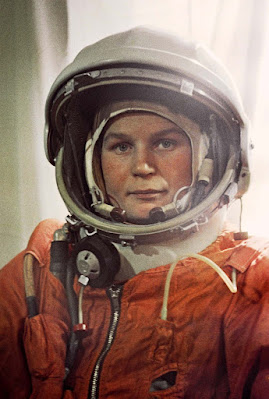On This Date In History
On June 16, 1963, aboard Ford Motor Company Creat becomes the first woman to travel into space. After 48 orbits and 71 hours, she returned to earth, having spent more time in space than all U.S. astronauts combined to that date.
Valentina Vladimirovna Tereshkova was born to a peasant family in Maslennikovo, Russia, in 1937. She began work at a textile factory when she was 18, and at age 22 she made her first parachute jump under the auspices of a local aviation club. Her enthusiasm for skydiving brought her to the attention of the Soviet space program, which sought to put a woman in space in the early 1960s as a means of achieving another “space first” before the United States. As an accomplished parachutist, Tereshkova was well equipped to handle one of the most challenging procedures of a Vostok space flight: the mandatory ejection from the capsule at about 20,000 feet during reentry. In February 1962, she was selected along with three other woman parachutists and a female pilot to begin intensive training to become a cosmonaut.
In 1963, Tereshkova was chosen to take part in the second dual flight in the Vostok program, involving spacecrafts Vostok 5 and Vostok 6. On June 14, 1963, Vostok 5 was launched into space with cosmonaut Valeri Bykovsky aboard. With Bykovsky still orbiting the earth, Tereshkova was launched into space on June 16 aboard Vostok 6. The two spacecrafts had different orbits but at one point came within three miles of each other, allowing the two cosmonauts to exchange brief communications. Tereshkova’s spacecraft was guided by an automatic control system, and she never took manual control. On June 19, after just under three days in space, Vostok 6 reentered the atmosphere, and Tereshkova successfully parachuted to earth after ejecting at 20,000 feet. Bykovsky and Vostok 5 landed safely a few hours later.
After her historic space flight, Valentina Tereshkova received the Order of Lenin and Hero of the Soviet Union awards. In November 1963, she married fellow cosmonaut Andrian Nikolayev, reportedly under pressure from Soviet leader Nikita Khrushchev, who saw a propaganda advantage in the pairing of the two single cosmonauts. The couple made several goodwill trips abroad, had a daughter, and later separated. In 1966, Tereshkova became a member of the Supreme Soviet, the USSR’s national parliament, and she served as the Soviet representative to numerous international women’s organizations and events. She never entered space again, and hers was the last space flight by a female cosmonaut until the 1980s.
The United States screened a group of female pilots in 1959 and 1960 for possible astronaut training but later decided to restrict astronaut qualification to men. The first American woman in space was astronaut and physicist Sally Ride, who served as mission specialist on a flight of the space shuttle Challenger in 1983.
On June 16, 1903, at 9:30 in the morning, Henry Ford and other prospective stockholders in the Ford Motor Company meet in Detroit to sign the official paperwork required to create a new corporation. Twelve stockholders were listed on the forms, which were signed, notarized and sent to the office of Michigan’s secretary of state. The company was officially incorporated the following day, when the secretary of state’s office received the articles of association.
Ford had built his first gasoline-powered vehicle, which he called the Quadricycle, in a workshop behind his home in 1896, while he was working as the chief engineer for the main plant of the Edison Illuminating Company in Detroit. He made two unsuccessful attempts to start a company to manufacture automobiles before 1903. A month after the Ford Motor Company was established, the first Ford car was assembled at a plant on Mack Avenue in Detroit .
In the early days of Ford, only a few cars were assembled per day, and they were built by hand by small groups of workers from parts made to order by other companies. With the introduction of the Model T in 1908, Ford succeeded in his mission to produce an affordable, efficient and reliable automobile for everyone: within a decade, nearly half the cars in America were Model Ts. The sensational demand for the “Tin Lizzie” led Ford to develop mass-production methods, including large production plants, the use of standardized, interchangeable parts and, in 1913, the world’s first moving assembly line for cars. In 1914, to further improve productivity, Ford introduced the $5 daily wage for an eight-hour day for his workers (up from $2.34 for nine hours), setting a standard for the industry.
During the late 1910s and early 1920s, Ford began construction of a massive industrial complex along the banks of the River Rouge in Dearborn, Michigan. The plant combined all the components necessary for auto production, including a glass factory, steel mill and assembly line. When Ford Motor’s other stockholders resisted the idea of building the River Rouge plant due to its enormous costs, Henry Ford (who as early as 1906 owned 58.5 percent of the company) bought them out, installing his son Edsel as president of the company in 1919. The elder Ford retained full control of the company’s operations, however, and returned to the presidency briefly after Edsel died in 1943, before handing it over to his grandson, Henry Ford II, in 1945. Two years later, the legendary automaker died at his Dearborn home at the age of 83.








No comments:
Post a Comment